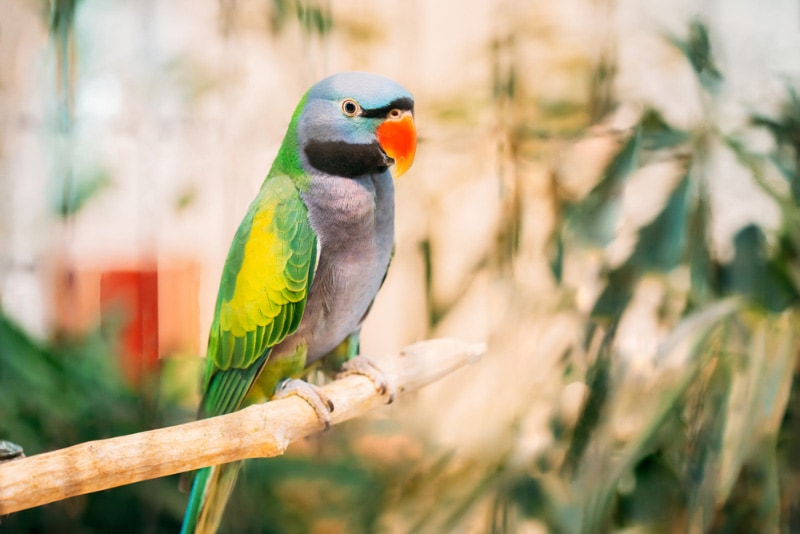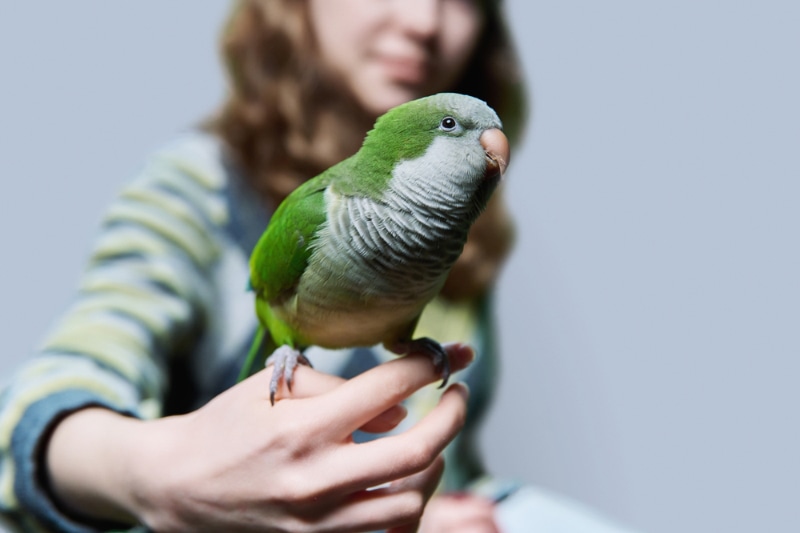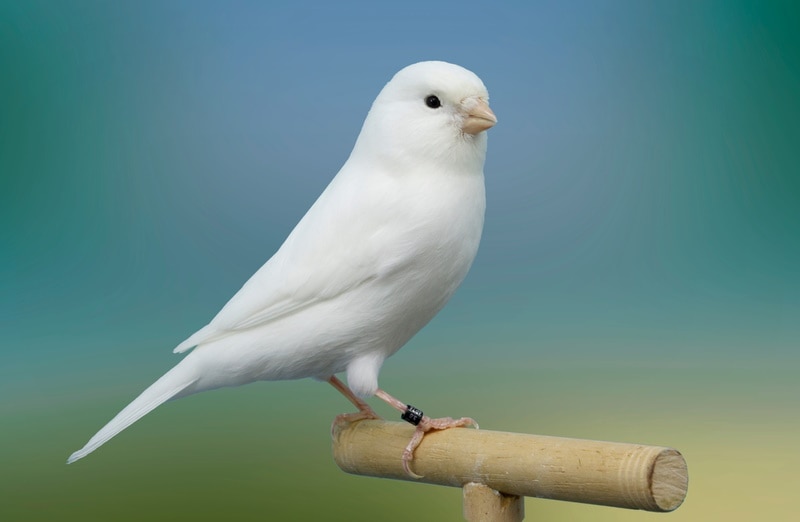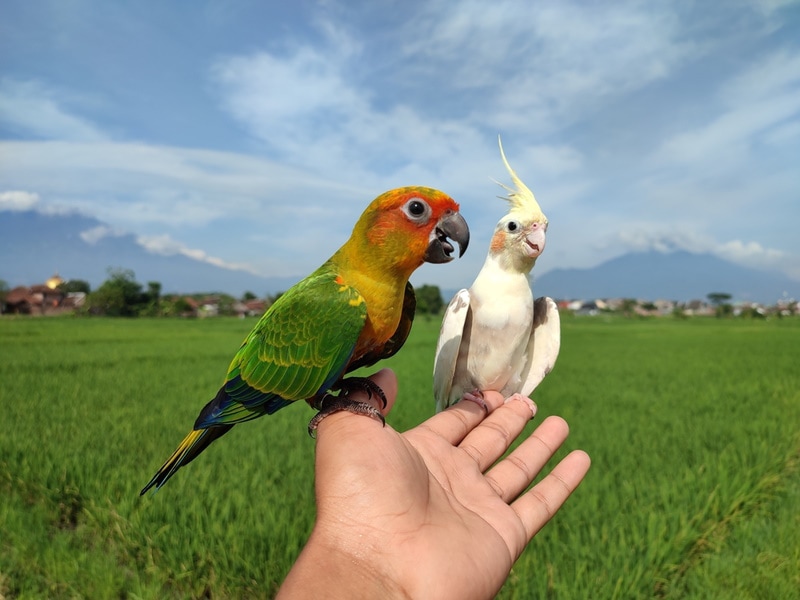Derbyan Parakeet: Info, Pictures, Personality & Care Guide
Updated on
Click to Skip Ahead
If you’re searching for an exotic pet as social and affectionate as a dog, the Derbyan parakeet (Psittacula derbiana) could be for you. They originate from an isolated part of the world, but Derbyan parakeets show a different side of themselves with their human companions.
Several parrot species are, unfortunately, facing extinction from poaching and habitat destruction. At this time, the Derbyan parakeet population is slowly declining but is nothing of major concern. However, they are considered near threatened. If you do happen to find one for sale, you should ensure your parakeet comes from a reputable breeder with proper documentation.
Species Overview
| Color: |
Mostly green legs, wings, and neck with luminous purple-blue markings on the head, chest, and belly. Females and males have black facial stripes.
|
| Size: | 19.5 inches |
| Weight: | 11.2 ounces |
| Wingspan: | About 24 inches |
The Derbyan parakeet is one of the larger breeds of parakeets, measuring almost twice the size of a standard house parakeet. Despite them being large, they still make popular pets amongst bird enthusiasts.
Derbyan parakeets are highly social birds, so much so that they’re willing to snuggle and talk with their humans. Additionally, Derbyan parakeets outlive dogs, cats, and other traditional domestic pets by decades, making them truly unique pets.

Derbyan Parakeet Bird Characteristics

History & Natural Habitat
Derbyan parakeets claim the Himalayan subalpine conifer forests as their home, stretching from India’s Northeastern mountainous range to Southeastern Tibet and into Southern China. Here, the forest transitions from dense alpine forest to open meadows. Derbyan parakeets congregate in flocks of 40 birds or more and stay relatively quiet in the trees.
It’s hard to say when the Derbyan parakeet was discovered. Many animals in this region were never heard of until China took over Tibet in the 1950s. However, Derbyan parakeets have been slowly introduced worldwide since the early 1800s.

Things to Know When Owning a Derbyan Parakeet:
Temperament
Derbyan parakeets are easy-going, social birds who will get along with just about anyone. They appear shy at first but eventually develop special relationships with their humans and even show outward affection.
Derbyan parakeets are highly intelligent, curious birds. They make fun pets to train and enjoy the mental stimulation. Their desire to learn and socialize means they can become bored easily and develop unwanted chewing habits. Toys, engaging activities, and socialization will help keep your parakeet happy.
Sounds, Speech & Vocalizations
Derbyan parakeets love to talk and are very noisy when they do. For this reason, they don’t do well in apartments.
Derbyan parakeets make an “ah-ah” clanging sound, similar to crows and ravens. It’s loud and can be heard from a long distance away. When happy, they sometimes purr and can even be trained to imitate human speech. With proper training, your Derbyan can learn to form complete sentences.

Derbyan Parakeet Appearance
Derbyan parakeets are known as sexually dimorphic, meaning the males look different from the females. Still, they both have similarities in their color patterns that tie the breed together.
Both birds are mostly green on their backs and the nape of the neck. The stomach is a light purple, fading to blue as it nears the top of the head. Black facial stripes wrap around the forehead, chin, and neck.
The biggest differences between the male and female birds are the beaks. The females have an all-black beak whereas the males have an orange-red beak.
Even young Derbyan parakeets have to grow into their colorful features. Young Derbyan feathers may appear dull. For instance, the black stripes appear greyer.
Caring for the Derbyan Parakeet
Happy Derbyan parakeets receive frequent training and time to explore their surroundings and hang out with their humans. To give you an idea of how social these birds are, they’re often found in flocks of 40 or more. They especially love the one-on-one interaction and often talk to you or rest on your shoulder while you relax.
Derbyan parakeets need a large cage to stretch their wings when you’re not home. Toys can keep them preoccupied until it’s time to explore outside the cage. You can have two Derbyan parakeets in the same cage for company, although it’s not required.
Wing Clipping and Nail Trimming
Wing trims prevent your bird from escaping, but it’s not foolproof. Birds can still glide away on a windy day, so watch over your bird as if their wings were intact. Either a veterinarian or someone trained to handle birds must do the wing trimming.
Nail trimming helps prevent scratches when you hold or handle your bird. Rough objects like concrete perches and wood can naturally trim nails, but sometimes we have to intervene. Be careful to not overdo the nail trimming, though. They offer stability for your bird to perch, and we don’t want them falling off.
All you need to do is trim the tip of the nail just enough to make the nail dull. Young birds will need time to get used to this grooming practice.

Beaks
Beaks can accumulate too much keratin on the tips and need sanding with specialized tools. A veterinarian who handles birds can do this. More often than not, naturally rough surfaces like wood and concrete do the job.
Diet & Nutrition
Derbyan parakeets need seeds and pellets as their diet staples. To add variety, offer a range of fruits, veggies, and legumes. Avoid avocados, chocolate, and any processed foods, as these are generally toxic to birds.
Malnutrition tends to come from birds being fed an all-seed diet. Although delicious, seeds are high in fat and lack vital vitamins and minerals, so be sure to add as much variety to your Derbyan’s diet as possible, with the main source coming from parrot pellets.
Cage/Housing Requirements
Birds need plenty of space to spread and flap their wings. They also need space to stand, jump, and fly to a top perch. In addition, ensure the bar spacing on the cage is narrow enough so that your bird can’t escape. A good rule of thumb is to multiply your bird’s wingspan and height by three for adequate dimensions. However, the larger their enclosure, the happier they will be.
Exercise
Derbyans are active birds and love to stay busy, so they’ll love time outside the cage and one-on-one interaction with you. Provide ample room for play, inside or outside the cage, and also have toys on hand for games.
It’s wise to train your bird not only for mental stimulation but also so your bird understands how to interact with humans. Thankfully, Derbyans excel in target training, especially when there are treats involved.
Health & Conditions
Derbyan parakeets are relatively healthy birds, but they can fall prey to poor diet and neglect. Derbyans should never be left alone for too long. If they do, depression, lethargy, and skin problems can occur.


3 Little-Known Facts About the Derbyan Parakeet
1. They’re a Threatened Breed
We mentioned earlier that the Derbyan parakeet population is slowly dwindling, but how concerned are scientists?
There are nine extinction levels, three of which fall into the threatened category. Right now, scientists list the species as near threatened, meaning the population is declining and should be carefully watched.
2. They’re Nicknamed the Lord Derby Parakeet
The Derbyan parakeet was named after Edward Smith-Stanely (1775–1851), the 13th Earl of Derby. He loved nature so much that he created a large library of natural history books at his home. Of all of the books, over 1,000 were about birds.
3. Their Colors Help Camouflage Them
Derbyan parakeets aren’t pretty because they’re lucky; their colors act as camouflage, blending in with the trees and sunlight beams.
Conclusion
The Derbyan parakeet is a beautiful bird with a fun, social personality. Anyone who wants a pet with a dog-like personality would love to have this bird. Derbyans are difficult to find in the US, so you’d have to do extensive research on breeders. Be willing to spend hundreds if not thousands on this bird breed.
Featured Image Credit: George Trumpeter, Shutterstock












